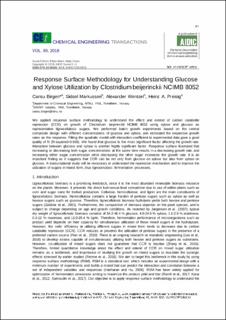| dc.contributor.author | Birgen, Cansu | |
| dc.contributor.author | Markussen, Sidsel | |
| dc.contributor.author | Wentzel, Alexander | |
| dc.contributor.author | Preisig, Heinz A. | |
| dc.date.accessioned | 2023-05-31T13:31:14Z | |
| dc.date.available | 2023-05-31T13:31:14Z | |
| dc.date.created | 2018-07-05T20:17:34Z | |
| dc.date.issued | 2018 | |
| dc.identifier.citation | Chemical Engineering Transactions. 2018, 65, 61-66. | en_US |
| dc.identifier.issn | 1974-9791 | |
| dc.identifier.uri | https://hdl.handle.net/11250/3069520 | |
| dc.description.abstract | We applied response surface methodology to understand the effect and extend of carbon catabolite repression (CCR) on growth of Clostridium beijerinckii NCIMB 8052 using xylose and glucose as representative lignocellulosic sugars. We performed batch growth experiments based on the central composite design with different concentrations of glucose and xylose, and estimated the respective growth rates as the response. Fitting the quadratic model with interaction coefficient to experimental data gave a good quality of fit (R-squared=0.939). We found that glucose is the most significant factor affecting the growth rate. Interaction between glucose and xylose is another highly significant factor. Response surface illustrated that increasing or decreasing both sugar concentrations at the same time results in a decreasing growth rate, and increasing either sugar concentration while decreasing the other sugar increases the growth rate. It is an important finding as it suggests that CCR can be not only from glucose on xylose but also from xylose on glucose. A transcriptional study will be necessary to understand the repression mechanism and to improve the utilization of sugars in mixed form, thus lignocellulosic fermentation processes. | en_US |
| dc.language.iso | eng | en_US |
| dc.publisher | AIDIC | en_US |
| dc.title | Response Surface Methodology for Understanding Glucose and Xylose Utilization by Clostridium beijerinckii NCIMB 8052 | en_US |
| dc.type | Peer reviewed | en_US |
| dc.type | Journal article | en_US |
| dc.description.version | publishedVersion | en_US |
| dc.source.pagenumber | 61-66 | en_US |
| dc.source.volume | 65 | en_US |
| dc.source.journal | Chemical Engineering Transactions | en_US |
| dc.identifier.doi | 10.3303/CET1865011 | |
| dc.identifier.cristin | 1596013 | |
| dc.relation.project | Norges forskningsråd: 257622 | en_US |
| dc.relation.project | Norges forskningsråd: 521732 | en_US |
| cristin.ispublished | true | |
| cristin.fulltext | original | |
| cristin.qualitycode | 1 | |
